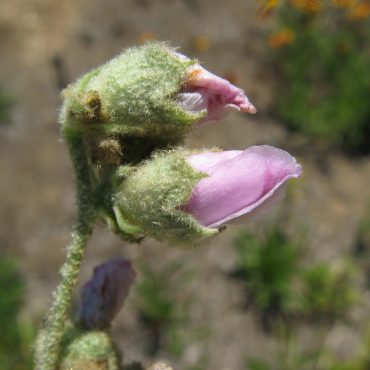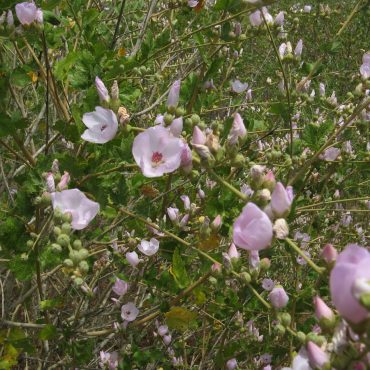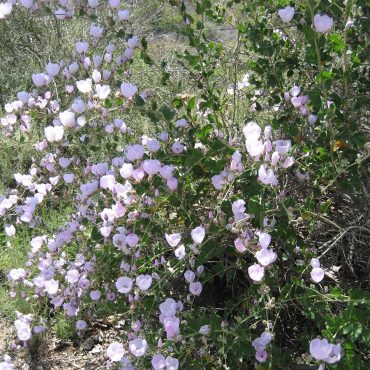If, as mythology suggests, mallows are a gift from the gods, those gods chose well. Chaparral mallow (Malacothamnus fasciculatus) is one of the most eye-catching, photogenic flowers in the Reserve – delicate pink with a central spray of red and yellow stamens and red styles. Chaparral mallow is an open shrub with soft gray-green leaves. In early summer the long, wanding branches are studded with clusters of the charismatic flowers.
Chaparral Mallow
Malacothamnus fasciculatus
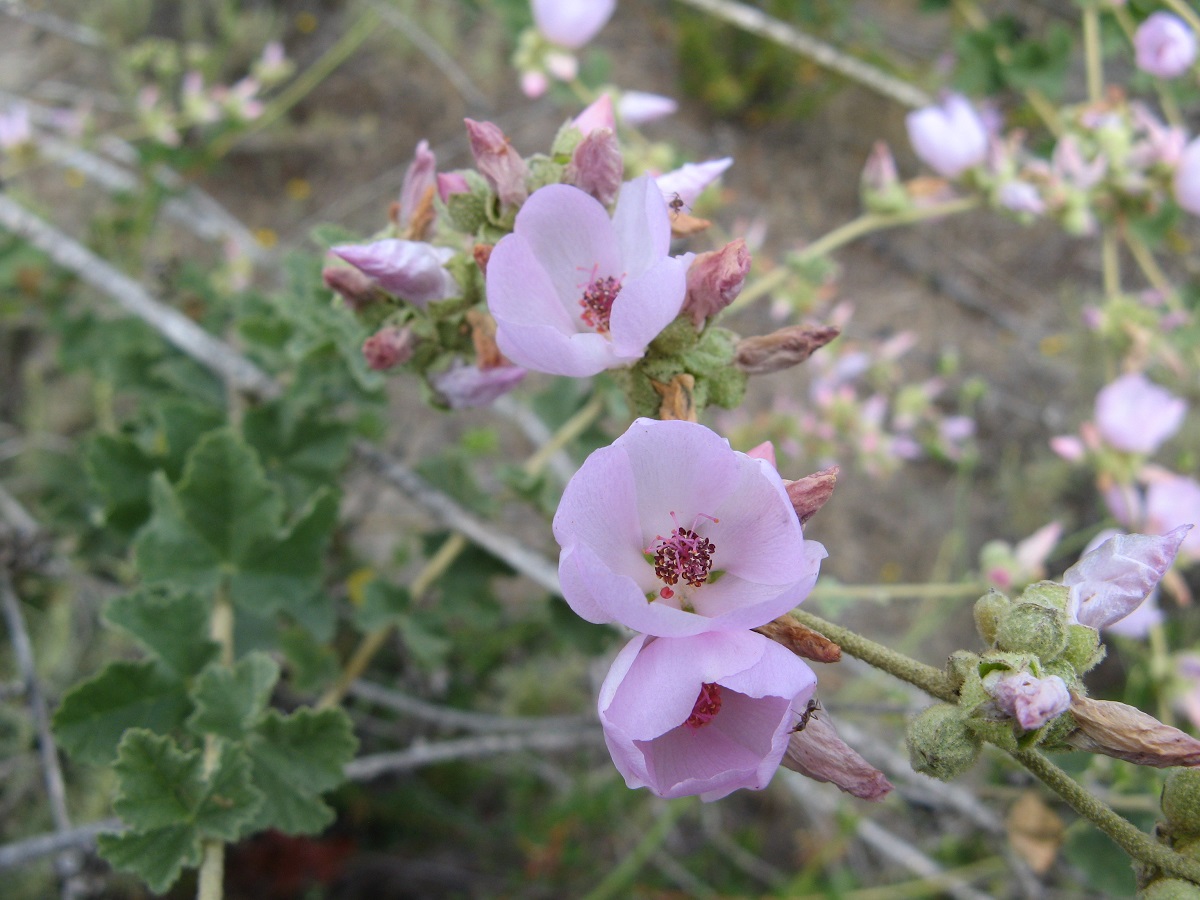
Other Common Names:
Bush mallow, chaparral bush mallow, Mendocino bushmallow
Description 4,11,26,59 306
Chaparral mallow is a large, somewhat woody shrub that rarely reaches fifteen feet high. Stems are slim, often sparsely branched and upright or arching outward, sometimes to the ground. An extensive root system may send up multiple stems making dense thickets.24 Plants are densely covered with short, stiff, whitish stellate hairs, which give the plant a rough texture.
Leaves are ovate to five-sided in outline, often heart-shaped at base and shallowly, palmately lobed with three to five lobes. Leaves are up to 2¾ inches (7 cm) long and 2¼ inches (5.8 cm) wide on petioles less than 1/3 the leaf length. Leaf margins are irregularly toothed.
Pale flowers occur in whirls of three to several flowers all along the outer portions of the branches. Flowers are bisexual, about one inch (2.5 cm) across, with five sepals and five pale pink petals. Sepals are united into a short tube with five deltate lobes equal to or less than the length of the tube. Small, linear bracts at the base of the sepals are difficult to see because of the short petioles and crowded flowers. Petals are obovate, overlapping on the outer portions, not touching at the bases. The numerous stamens are attached by their filaments into a long, slim tube around the pistil filaments and anthers spray out at the top into a pom-pom; Petal bases are attached to the base of this tube, Filaments are white, becoming pink; anthers are maroon to red-orange with yellow pollen. There is a single pistil with a superior ovary The red style is divided at the outer end into several linear segments, each with a small capitate stigma, all surrounded by the stamens. Flowers within a cluster open at different times; most clusters have at least one open bloom so a plant in full flower may have thousands of open flowers. The main bloom period occurs between April and July, but given adequate rainfall, blooms may occur over much of the year.1,7,11
The stamens and petals fall off the flower as a unit; the sepals remain, enclosing the developing fruit. The fruit resembles a “cheese wheel”, a disk-shaped seed capsule that consists of several one-seeded, wedge-shaped chambers, arranged in a wheel. When the fruit is ripe, the entire capsule breaks apart into individual chambers, releasing chambers, chamber walls and triangular seeds, which are dark and covered with white stellate hairs.
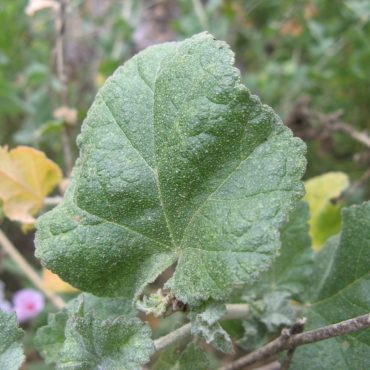
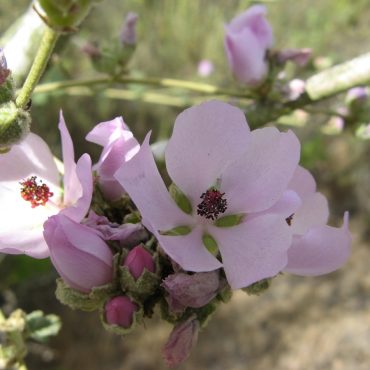
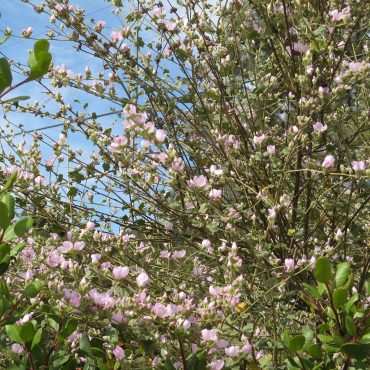
Distribution 7,89,306
Chaparral mallow is native to California, northern Baja California and Sonora, Mexico, below 2000 feet (600 m). There are a few records from southwestern Arizona. In California, it is primarily south of Point Conception, a coastal shrub associated with chaparral and sage scrub vegetation. It is especially abundant after disturbances, including fires.59,174
It is possible that the plants in the Reserve were originally introduced in restoration projects.271 Twenty-five years ago, several plants were established as a part of a revegetation project along the spur-trail between the Santa Helena trailhead and the main east-west trail. These thrived for many years, but since 2009 they have largely disappeared. Another small clump was planted at the top of Holmwood Canyon. These have grown in size and spread down the canyon and now occur scattered throughout Central Basin. Recently, chaparral mallow has been planted in Nature Collective restoration areas on Stonebridge Mesa and at Santa Carina.
Learn more about plant vegetation types here
Classification 2,11,143
Chaparral mallow is a dicot angiosperm in the mallow family (Malvaceae). Mallows are familiar to most people – picture a hollyhock (Alcea spp.) or hibiscus (Hibiscus spp.). The typical mallow has numerous stamens with the filaments united into a tube around the pistil, and with the anthers sprayed out in a ball at the top. Flowers are surrounded by small, leaf-like bracts, and plants are often covered with small, white, stellate hairs. Many plants contain natural gums, which can be whipped into a froth. Leaves have palmate veins and are often palmately lobed. Fruit are various, but many resemble “cheese wheels”, disk-shaped seed capsules consisting of several one-seeded chambers. When the seeds are released, the entire capsule breaks apart into individual chambers.
There are several well-known species of mallow, including hollyhock, hibiscus, okra (Abelmoschus esculentus), cotton (Gossypium spp.) and the source of the original marshmallow (Althaea officinalis).
Five species of mallow have been reported from the Reserve.48 In addition to chaparral mallow, there is checkerbloom (Sildalcea sparsifolia), alkali mallow (Malvella leprosa) and the endangered island mallow (Malva assurgentiflora), which are native, and cheeseweed (Malva parviflora) which has been introduced.
Chaparral Mallow is a variable species which intergrades with similar related species.306 Several varieties and subspecies have been described which can be difficult to distinguish.41,290,306 The variety described from the Reserve is var. fasciculatus.48
Alternate Scientific Names:
Malacothamnus arcuatus, Malacothamnus mendocinensis, Malacothamnus parishi, Malvastrum nesioticum var. nuttallii, Malvastrum mendocinense, Malvastrum hallii
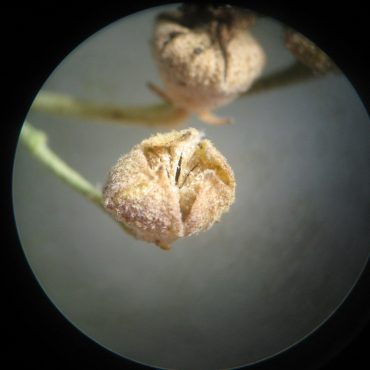

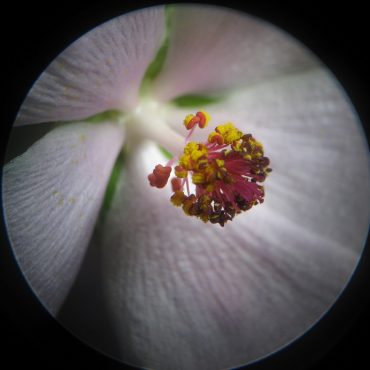
Ecology
Since the time of Darwin it has been recognized that the progeny of self-pollinated plants are, on the average, less successful than those of cross-pollinated plants. Flower structure appears to be designed in various ways to promote cross-pollination. In extreme cases, male and female structures are segregated into different flowers or different plants. In the case of chaparral mallow, the several styles and stigmas are surrounded by a dense cluster of stamens which might seem to ensure self-fertilization. However, the stamens develop first and the stigmas do not become receptive until the pollen has been shed and the stamens have fallen aside.4 This arrangement wherein the male structures mature before the female structures is known as protandry.
Recent research suggests that this subject is much more complex than previously realized.41
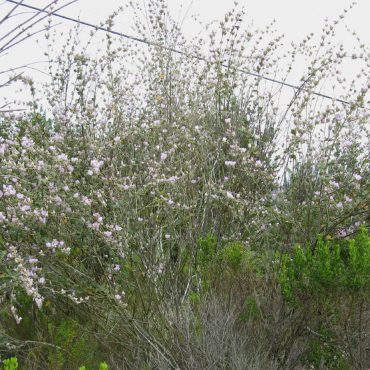
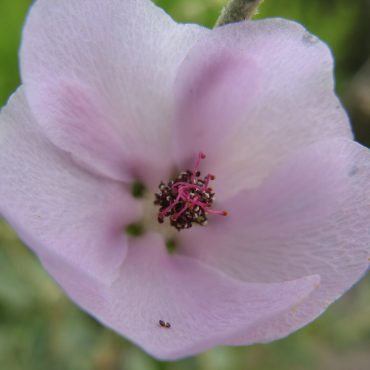
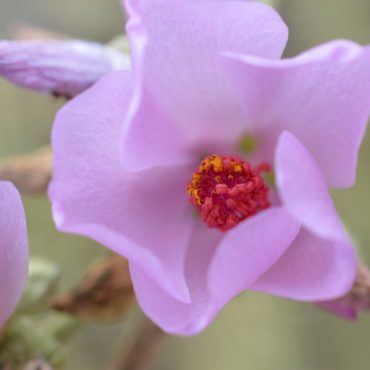
Human Uses
The Chumash used the bark of the chaparral mallow or the stem fibers below the bark to make cordage. This was woven into sacks for gathering bulbs.15 The Luisaño made an emetic from a decoction of the leaves.15
In modern times, chaparral mallow is used for erosion control24,290 and revegetation projects, including those of the Nature Collective at Santa Carina and on Stonebridge Mesa. It is often recommended for native gardens.24,168,169,290 Some sources warn, however, that the rapid thicket formation may be too “exuberant” for some gardens. The short life span is another drawback.24 Chaparral mallow attracts a wide variety of wildlife from birds and butterflies, to deer, rabbits and grasshoppers.24,169


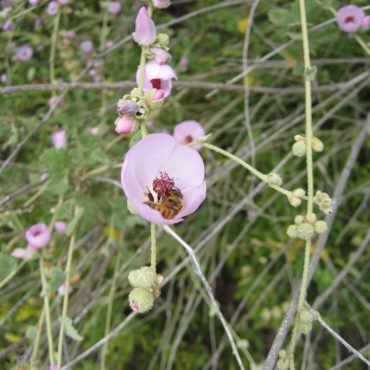
Interesting Facts 358
According to mythology, mallows were the first gift the gods made to mankind, sent as proof of their good will.
